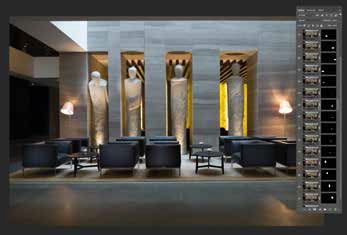articles/Lighting/splashtheflash-page4
Splashing the Flash - part 4 of 1 2 3 4
by Terry Donnelly Published 01/04/2017

4
Working the flash in small areas at a time, I point the speed-light towards the area I want to splash the light in, and fire the camera from the remote shutter available on the iPad via the Camranger software. As the shutter opens on the camera, the hot-shoe-mounted radio trigger sends a signal to the off-camera speed-light I am holding, and fires the speed-light. A copy of the photograph is then transmitted by the Camranger to my iPad and other connected devices, giving me instant feedback without having to return to the camera, which could be some distance away. This saves a lot of time, and allows me to adjust the angle and distance of the speed-light from the subject (and hence spread of light) and power of the speed-light for the next shot. This procedure is repeated around the set until I have lit all the areas of interest with the speed-light in multiple photographs.
The photographs are then loaded as layers in Photoshop, and blended using layer blending modes and masks to make a final image from all the layers. This may initially sound like a complicated task in Photoshop, but by changing the layer blending mode to Lighten and using masks to hide areas on the layer we don’t want to show, it is an extremely fast and effective method of finalising the picture.
By changing the layers blending mode to Lighten, it only shows the lighter pixels on the layer when compared to the layer below. In other words, it only shows the area affected by the flash. The Lighten blend mode looks at the colour information on the current layer and the layer below, and shows the lighter of the pixel information on those two layers, and thus allows the lighter area (the results of the flash) to be shown. By adding a layer mask to this layer, we can then limit and control the spread and brightness of the lighter areas and finesse the result buy using the opacity slider and a softedged brush to add to the layer mask and hide or reveal various parts of that layer (including me holding the flash unit) [image 4]. This procedure is repeated for all the additional layers, containing the results of using the flash on different areas of the set.
The final image was then cropped, some cloning, colour adjustment and tidying up carried out to finalise the image as shown.
On this particular job, I was shooting between 12 and 14 sets per day, and my ‘Splash the Flash’ technique allowed for a fast workflow, with minimal equipment, which ensured an effective way of lighting a large set in a public area, with the ability to move quickly and having the bonus of having less equipment to be moved around.
The ‘Splash the Flash’ technique may be offered as a workshop at the next Convention in 2018 if you would like to learn this technique hands on.
Please Note:
There is more than one page for this Article.
You are currently on page 4
- Splashing the Flash page 1
- Splashing the Flash page 2
- Splashing the Flash page 3
- Splashing the Flash page 4
1st Published 01/04/2017
last update 09/12/2022 14:59:11
More Lighting Articles
There are 0 days to get ready for The Society of Photographers Convention and Trade Show at The Novotel London West, Hammersmith ...
which starts on Wednesday 15th January 2025





